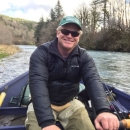Eagle Creek National Fish Hatchery spawns and rears juvenile coho salmon (Oncorhynchus kisutch) and winter steelhead trout (O. mykiss) that are released into Eagle Creek within the Clackamas River basin, Oregon. Previous investigations on the ecological and genetic impacts of hatchery winter steelhead in Eagle Creek during 2005-09 indicated that in some years natural production was influenced by naturally spawning hatchery fish. Using Passive Integrated Transponder (PIT) tag technology, we initiated a follow-up study to compare the abundance, growth, survival, and migration behavior of hatchery and wild winter steelhead in Eagle Creek, 2010-15. We compared an area of natural production most influenced by hatchery fish (upper Eagle Creek) to an area with less hatchery influence (North Fork Eagle Creek). Our hypotheses were that abundance, growth, and survival of naturally produced winter steelhead in upper Eagle Creek would be negatively impacted by naturally spawning hatchery fish. We were also interested in whether the migratory behavior of naturally produced fish in the two streams were similar to each other or exhibited patterns similar to hatchery fish. Problems were encountered with some of our sampling techniques and sample sizes were often low; nevertheless, we could not conclude that freshwater abundance, growth, survival, and migration behavior of naturally produced winter steelhead in upper Eagle Creek were negatively impacted by naturally spawning hatchery winter steelhead when compared to North Fork Eagle Creek. Juvenile and adult winter steelhead from upper Eagle Creek performed as well as, or better than, fish from North Fork Eagle Creek. Even though juvenile hatchery winter steelhead were found residualizing in upper Eagle Creek but not in North Fork Eagle Creek, relative growth and abundance of juvenile winter steelhead were higher in upper Eagle Creek. No significant differences were found in over-summer survival of juveniles or in survival to adult. The migration behavior for naturally produced winter steelhead from upper Eagle Creek and North Fork Eagle Creek were more similar to each other than to hatchery fish. Genetic samples from 2005, 2006, and 2007 were examined by Abernathy Fish Technology Center along with samples collected in 2010 and 2011 in order to estimate the contribution of hatchery and wild steelhead to natural production in each of the study sites. While both streams had evidence of hatchery-wild admixture, in three out of five years studied, the North Fork Eagle Creek had less hatchery influence than upper Eagle Creek. When making conclusions about genetic data, it was important to interpret the genetic impact of the hatchery in the context of the timeframe it was sampled. The hatchery influence from genetic samples collected in 2007, 2010 and 2011 was significantly higher in upper Eagle Creek than in North Fork Eagle Creek; however, in 2005 the hatchery influence was higher in North Fork Eagle Creek (no difference in 2006). Our findings support the need for periodic evaluation of the hatchery program in Eagle Creek to ensure parameters in the Hatchery and Genetic Management Plans and Section 7 Section 7
Section 7 Consultation
The Endangered Species Act (ESA) directs all Federal agencies to work to conserve endangered and threatened species and to use their authorities to further the purposes of the Act. Section 7 of the Act, called "Interagency Cooperation," is the mechanism by which Federal agencies ensure the actions they take, including those they fund or authorize, do not jeopardize the existence of any listed species.
Learn more about Section 7 Endangered Species Act Biological Opinion are met.
Publication date
Type of document
Annual Report
Facility
Program
Species
Ecosystem
FWS and DOI Region(s)





